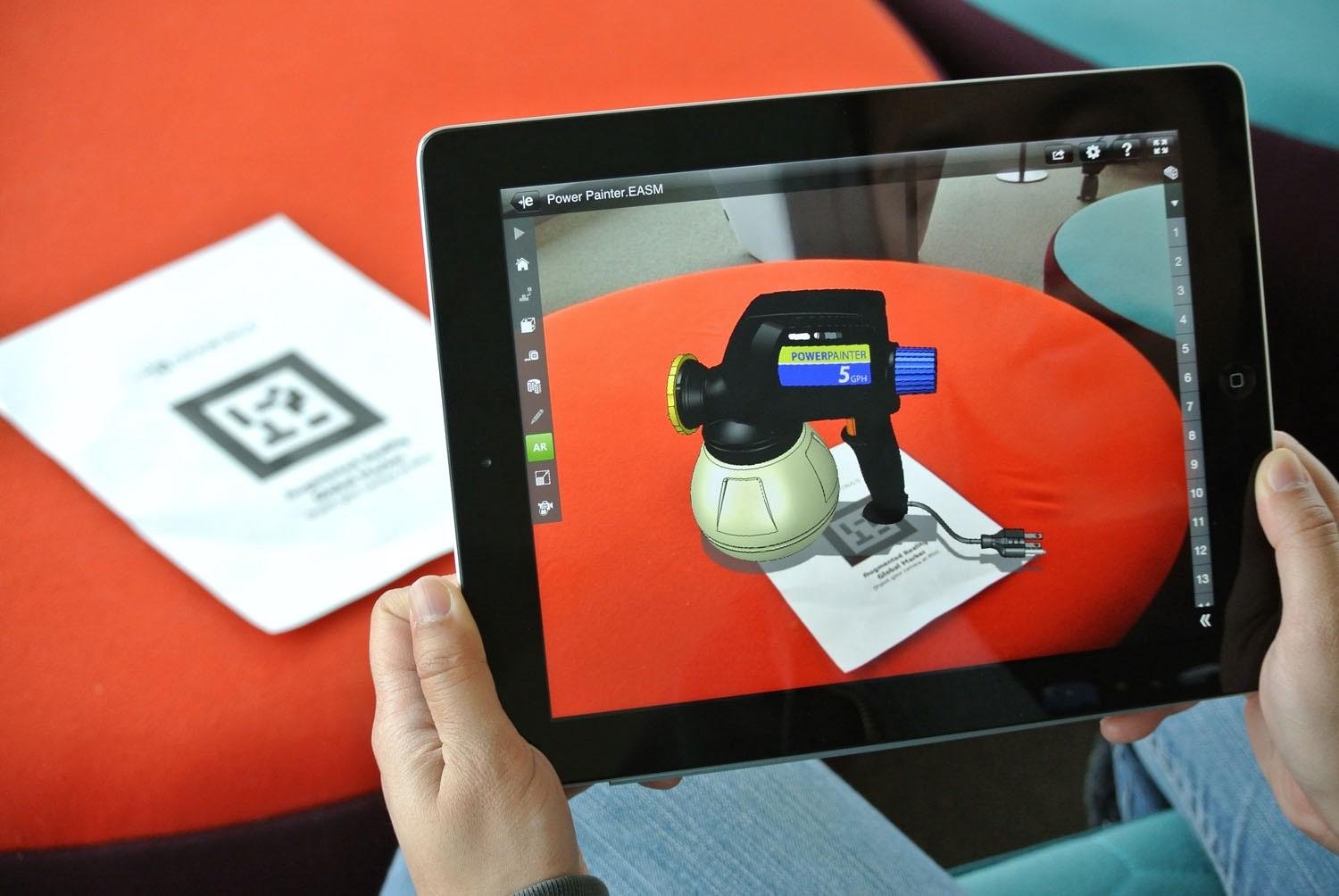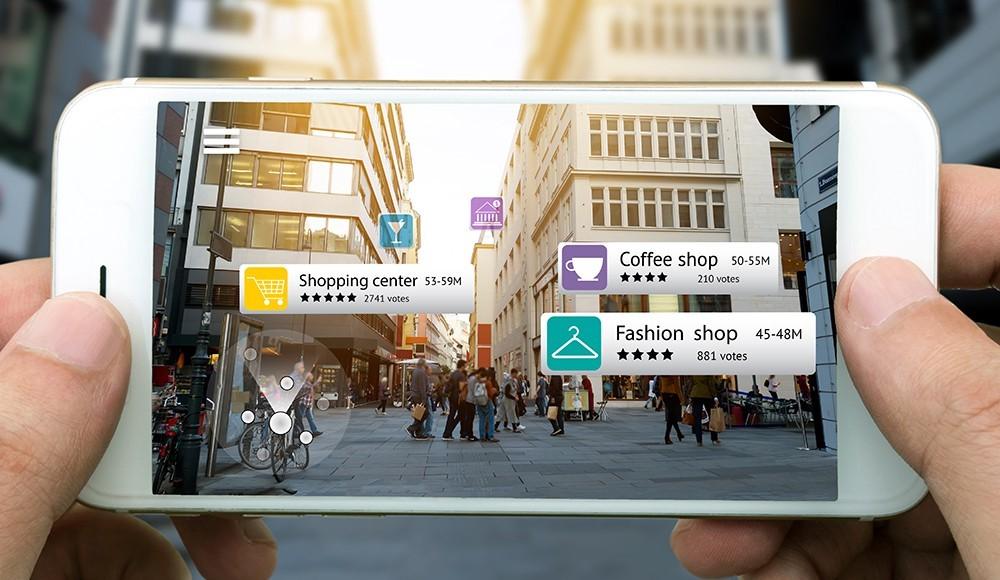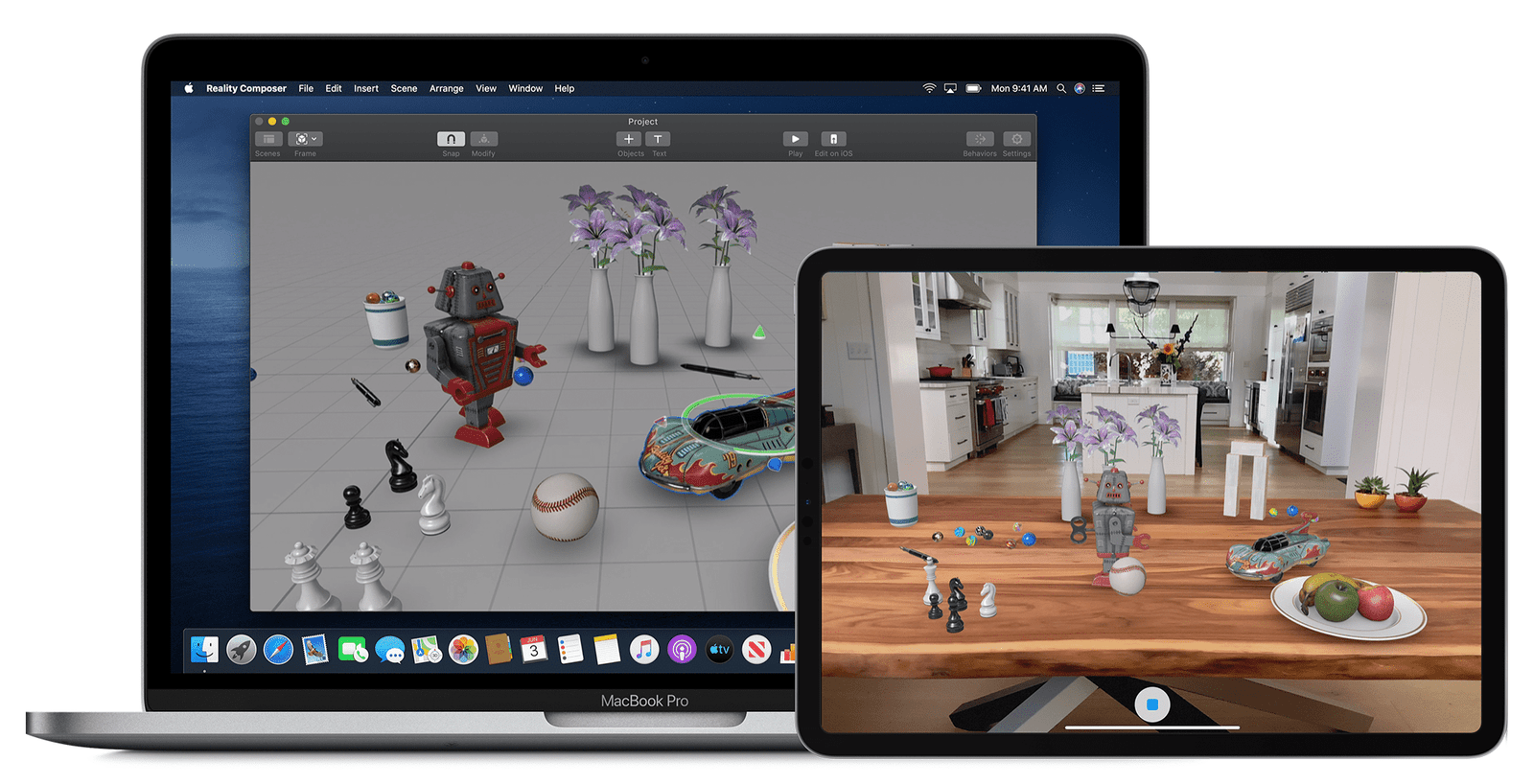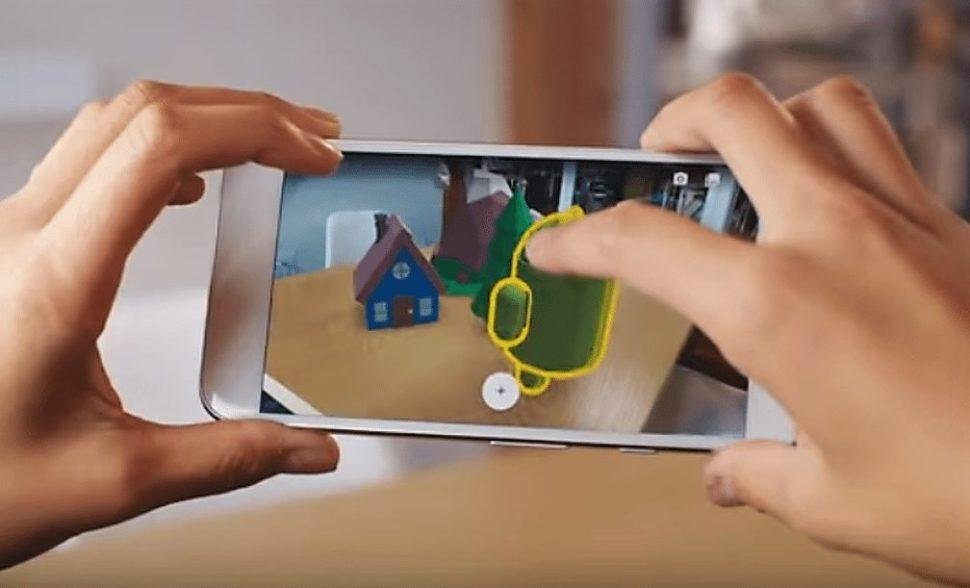Markerless Augmented Reality: Pros & Cons

By nature, augmented reality enables people to mix and match real-life objects with computer-generated 3D figures in real time. While many of these techniques have already been discussed here, several different strategies exist, including marker-based, markerless AR, and GPS-based solutions. Each has its advantages and disadvantages.
A growing market, augmented reality is expected to reach more than $198 billion in sales by 2025 (from $3.5 billion in 2017). However, despite the enormous potential of this industry, it is presently experiencing a significant transformation in terms of hardware and software.
Today, augmented reality is available on mobile devices and comes in three different forms: marker-based, markerless AR, and location-based. All have their own set of restrictions that developers are currently attempting to overcome in the future.
What is markerless augmented reality?
A mobile device with a markerless augmented reality app can be used to scan a static image referred to as a trigger picture, which is required for markerless augmented reality experiences. The mobile scan will cause the extra material (video, animation, 3D, or other) created in advance to appear on top of the marker.
It’s important to note that marker recognition is usually cloud-based, which implies that markers can be stored on a server, and recognition occurs there, with the phone merely sending point clouds to the server.
Recognition can be carried out straight from the device, but if cloud recognition is used, the content will need to be retrieved from the server. It generally takes a few moments for the user to view a markerless augmented reality experience.
The trigger image (marker) must be original. Avoid using stock pictures (if you are utilizing cloud-based apps) since other projects or applications may have previously used them. To prevent such problems, it’s better to capture your own material or develop a unique design.
The most frequent approach to creating a markerless AR application is to utilize it to identify flat surfaces and borders of locations (rooms, halls, etc.). As a result, the digital objects are represented at a realistic angle and take up the same amount of room in the space as they would in real life.
Examples of markerless AR
Stannah, a worldwide elevator/escalator firm, has developed markerless AR visualization software for potential customers. By utilizing this model, users can evaluate the design of their homes with a new stairlift from a different company.
A Silicon Valley firm uses AR to help customers make purchases without needing markers. Customers can use their app to see a variety of goods in their homes, particularly on joint surfaces like floors and desks, before making a purchase. They use cutting-edge phone sensors to scale and position the items realistically.
What to do if you need markerless AR services
There are several problems that users may encounter when trying to use markerless AR services. One problem is that the user’s mobile device may not be able to scan the trigger image correctly. Another problem is that the trigger image may not be original, which can cause the user to see the wrong content or no content at all. Finally, the user may not be able to see the content correctly if the app is not designed properly.
If you want marker-free AR services, CyberFox is the company to call. We’ll give you all the tools and resources you need to make your users feel like they’re in a different world.
Markerless AR projects with CyberFox
If you are looking for a professional markerless AR development company, CyberFox is the right choice. We have extensive experience developing AR apps and can create a unique and engaging experience for your users. Some of the advantages of working with us include:

Punctuality
We give you a realistic assessment of the work completion time. You always get the job right on time.

Flexibility
Based on your project, we will suggest how to achieve the best result. Just send the materials you have.

Knowledge
Our experience and knowledge allow us to offer the best solutions to show your ideas. If you have questions, just ask.

Speed
We perfectly understand when you need visualizations urgently. We work fast.

Experience
We share our expert opinion on how best to present your project because we care.

Saving time
You do not need to understand the software or 3D imaging technology. Everything is available at CyberFox.
If you are interested in markerless AR development services, contact us today to discuss your project in detail.
How does markerless AR work?
Markerless AR combines digital data in a physical location. Markerless AR recognizes things or specific points in a scene without prior knowledge of the environment, such as walls or junction points. The visual effect is frequently linked to computer graphics combined with real-world pictures. The first markerless AR systems employed a device’s location services and hardware to engage with existing AR resources and define its position and orientation in space.
Simultaneous localization and mapping (SLAM) technology has improved markerless AR image analysis accuracy. Virtual reality has become a ubiquitous phenomenon that is revolutionizing the field of gaming.
Another area whose applications are limitless includes markerless AR SLAM image tracking, in which cameras capture pictures of the environment and map out where virtual 3D objects should be placed. Even if the things aren’t in the user’s field of view, they don’t move when they walk around, and new images do not have to be scanned. Read our article on how to choose an AR solution for more information on SLAM markerless AR.
Marker vs. markerless augmented reality
Marker-based and markerless AR are the two most common ways to use AR. Early-stage AR technologies were based on markers; however, markerless AR is now the most common image recognition technology for AR apps.
Marker-based augmented reality applications employ markers (target images) to identify features in a space. These markers define where the AR software puts digital 3D content in the user’s visual field or via a camera feed.

The ability to generate AR without markers is called markerless AR. It works by determining the real-world details of an area and then creating virtual 3D objects that are dependent on them rather than using sensors. This distinction eliminates the need for object-tracking technologies.
Industries using markerless AR
Markerless AR is used by the retail, education, and game development industries. In addition, the technology is being adopted by more verticals, resulting in more significant data and feedback that designers and developers can utilize to create more consumer use cases.
Expanding the number of established use cases for markerless AR necessitates low-cost, readily available devices and cutting-edge software. Here’s a look at a few sectors that are embracing it:
Gaming: Gaming has seen the most effective implementation of markerless AR, but we’re still in the early stages of its development. Since the release of Pokémon Go, a continuous flow of AR games has flooded the market. With 3D content that is continuously updated, ARKit/ARCore makes it feasible to construct multi-user real-world games with 3D content that stays put.
The Facebook-owned Oculus, Microsoft’s HoloLens, and Samsung’s Gear VR are the most popular headset AR gaming and communication devices. These enormous corporations, however, continue to create new video games and applications.

Interior Design: Have you ever wished to test the design of new equipment in your kitchen? Or whether you have space for a new sectional and recliner in your living room? It’s possible to virtually place an appliance or sofa in the real world using markerless AR. Shoppers can practically furnish an entire room by experimenting with cabinet types and flooring to see how they look before purchasing. In IKEA’s example, customers no longer have to leave their houses to make purchases or design products, which is a step forward for customer experience. Other companies, like Amazon, Macy’s, IKEA, and Ashley Furniture, are also utilizing AR design and product visualization to offer customers the freedom to shop and create items at home. This trend is gaining momentum with each new generation of hardware and AR SDK updates.

Retail: Amazon is working with AR to engage customers better and improve the online buying experience for home goods like furnishings. Look forward to markerless AR displaying high-ticket items in 3D as a more advanced version of the try-before-you-buy option in the future. Customers who are hesitant to buy these items online might be more willing to purchase them if they were able to experience them. Amazon is not the only one: Wayfair, Walmart, Made.com, and Alibaba are among those attempting to catch up with Amazon regarding applied AR experiences.

Advertising: Historically, web advertisements originated as tracker-based print ads. The user places their device over the ad, and a 3D character emerges. The extraordinary thing about AR marketing is that it has finally broken free of its print cage, putting it in the physical world. Wayfair, the NBA, Sephora, and Gucci are just a few firms already utilizing AR advertising. These big companies have a distinct advantage in the augmented reality advertising market. When wearables become more popular, AR marketing will be even more revolutionary. Attendees and live events like the Super Bowl might freely move between different virtual layers of advertising content and football-related activities such as on-field data and real-time replays.

Education: Markerless AR’s capacity to overlay digital information on reality is a godsend for instructors who use the technology to illustrate complicated ideas. Anatomy 4D and Elements 4D are two notable educational apps from the first wave. Museums employ AR to complement their physical exhibits with meaningful digital information. Corporations and the US military use Microsoft’s HoloLens to create training scenarios and experiences on various themes, including airplane engine maintenance, combat medicine, and survival.

Healthcare: Consider an app that uses different color zones to indicate proximity to community flu and virus scares. Using their smartphone’s location, public health authorities deliver real-time public health warnings to at-risk communities through mobile apps. Surgeons can utilize a strong AI to overlay 3D models of human anatomy on a patient while remote attending surgeons observe in real time.

Tourism: AR applications that are location-based aid tourists in navigating unfamiliar locations. Visitors to Greece or Egypt can use AR to see notable monuments like the Parthenon and the pyramids firsthand. Users who want to stay in an expensive hotel but still see the sights can go to popular tourist locations and enjoy the sights without ever leaving their room. When sitting in front of your computer, travel websites can take you on a virtual tour of your next destination.

Entertainment: Movies and music have long been available on-demand, with high-quality audio and video. Markerless AR can lead the way to the next significant evolution in home entertainment by reimagining live concerts and sporting events. Imagine being able to see your favorite artist or athlete perform in person.
Markerless AR Software
User-centric markerless AR tracking in VR headsets will allow for limitless virtual environments that can change according to particular needs. The applications of markerless AR software that monitor motion through space have huge potential for autonomous vehicles and robotics technology.
Wheelchair users might use motorized chairs with integrated markerless AR tracking technology to navigate the physical world. Built-in obstacle avoidance and safe pathfinding capabilities would allow wheelchair users to traverse the real world. But, of course, the graphics would change, and they’d have to look at something in front of them to activate it. Autonomous cars can benefit from the same breakthroughs in eye-tracking technology.
Markerless AR SDKs
Hardware-based solutions like Google Tango have led to software-based SDKs like Google ARCore and Apple ARKit, which produce the same result without requiring specialized gear.
Markerless AR is now possible on hundreds of millions of smartphones and tablets thanks to these two platforms. Here’s a quick rundown of the most popular software development kits:
Apple’s ARKit: The ARKit SDK was first introduced in 2017 and brought essential AR capabilities (such as plane tracking and anchoring) to the iOS operating system. Millions of people had an AR-capable smartphone in their pocket overnight. The capabilities above are all included in iOS 11’s ARKit, which can detect and track objects in the real world, estimate light levels, and drive multiple sessions. The SDK is free to download for developers.

Google’s ARCore: ARKit and ARCore allow developers to build augmented reality applications for iOS devices. In early 2018, Google released ARCore, a free and open-source augmented reality platform that works similarly to Apple’s ARKit.

Marxent MxT Tracking: While ARKit and ARCore require a few seconds for initial installation, NetEqual’s proprietary AR tracking SDK, MTX Tracking, takes only a couple of milliseconds. The two SDKs are slow to establish a tracking plane and render a 3D item into the scene. With a few minor modifications, the app can work with ARKit or ARCore. The platform provides developers with a way to combine the strengths of each SDK and provide a high-quality AR experience to consumers. MTX uses relative positioning. The tracking space is adjusted based on the user’s position with the program. Since positioning items on the ground requires no user input, users can view augmentations quickly.
See our AR SDK Guide for more information on top Augmented Reality Software Development Kits, including a glossary of SDK jargon and tracking specialties.
![]()
Advantages of markerless augmented reality
Markerless AR eliminates the need for physical markers to activate virtual interaction, offering the following benefits:
- When you use AR, your range of motion improves dramatically.
- You can start the program with a portable device or a see-through headset, such as glasses or goggles.
- You can discuss the experience with others.
- You can see more of the environment for AR content.
With an AR-enabled program, it’s possible to place virtual things into a natural setting and have them stay in position without needing a target image. Users can also use Relative Tracking, for example, to explore a large room (about 3-4 meters for most indoor settings) – far beyond the range of any extended tracking currently available.
Disadvantages of markerless augmented reality
Despite the advantages of markerless AR technology over previous systems, problems persist. The technology is mainly limited to flat, textured surfaces to display virtual images correctly. Additionally, apps on mobile devices consume a lot of battery power.
The bottom line
The number of augmented reality applications available now is significant, and it continues to grow: among them are healthcare, autonomous driving, education, translation, and intelligent face scanning — and these are just a few examples.
However, because the requirements in each sector are distinct, the same form of augmented reality cannot be implemented across all of them. The most basic form of this technology is known as marker-based AR, which is divided into two categories: marker-based AR and markerless AR.
Within markerless AR, there are four types: location-based AR, projection-based AR, overlay AR, and contour AR. Each is designed for a particular purpose and is based on a distinct technological concept, as previously discussed.
However, markerless AR technology is mainly limited to flat, textured surfaces and is not widely accepted. CyberFox specializes in developing AR apps for various industries, including healthcare, education, and automotive.
we reply in 1 day









